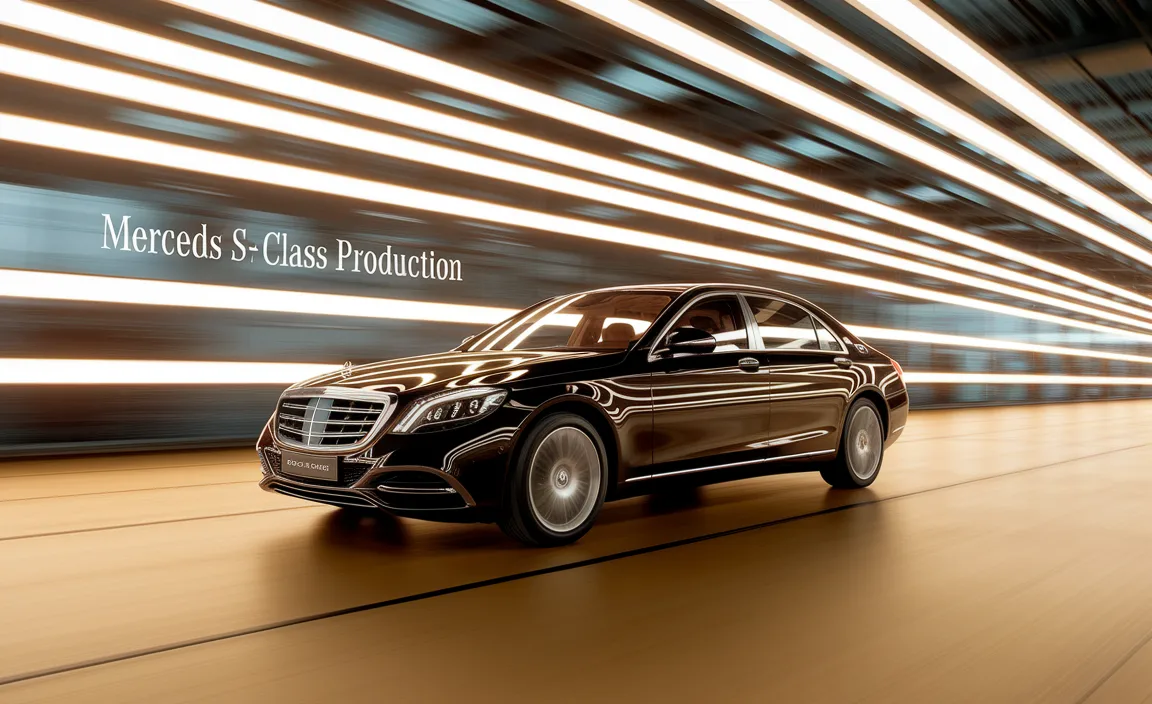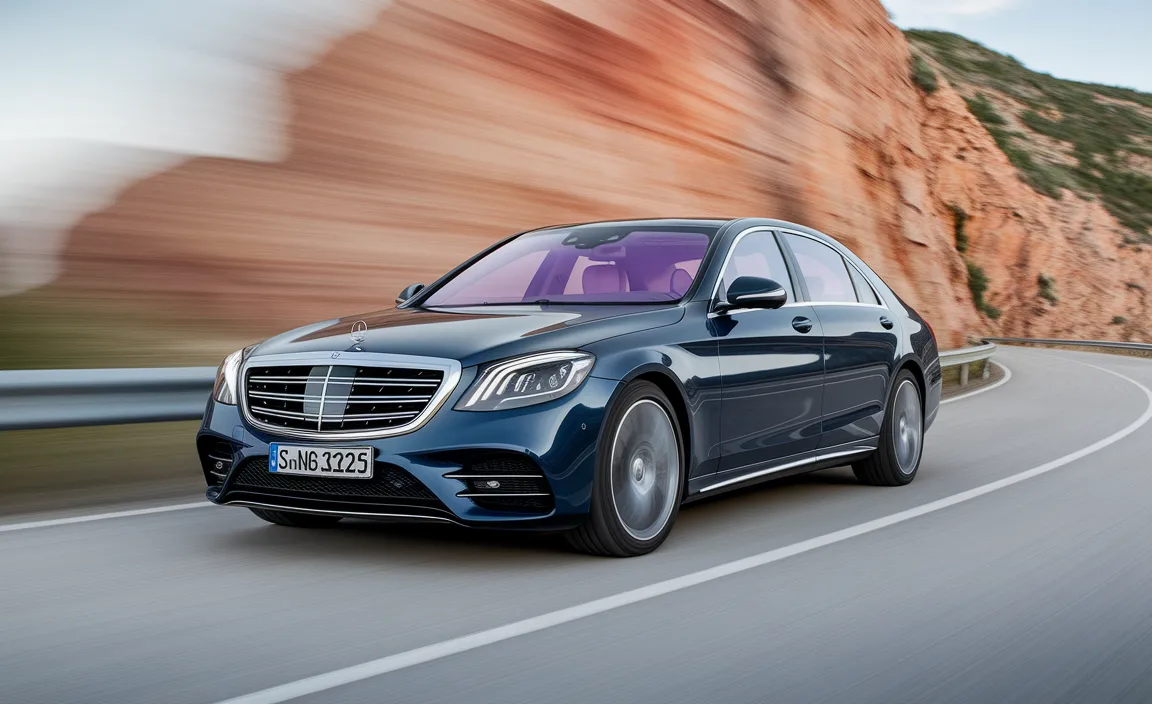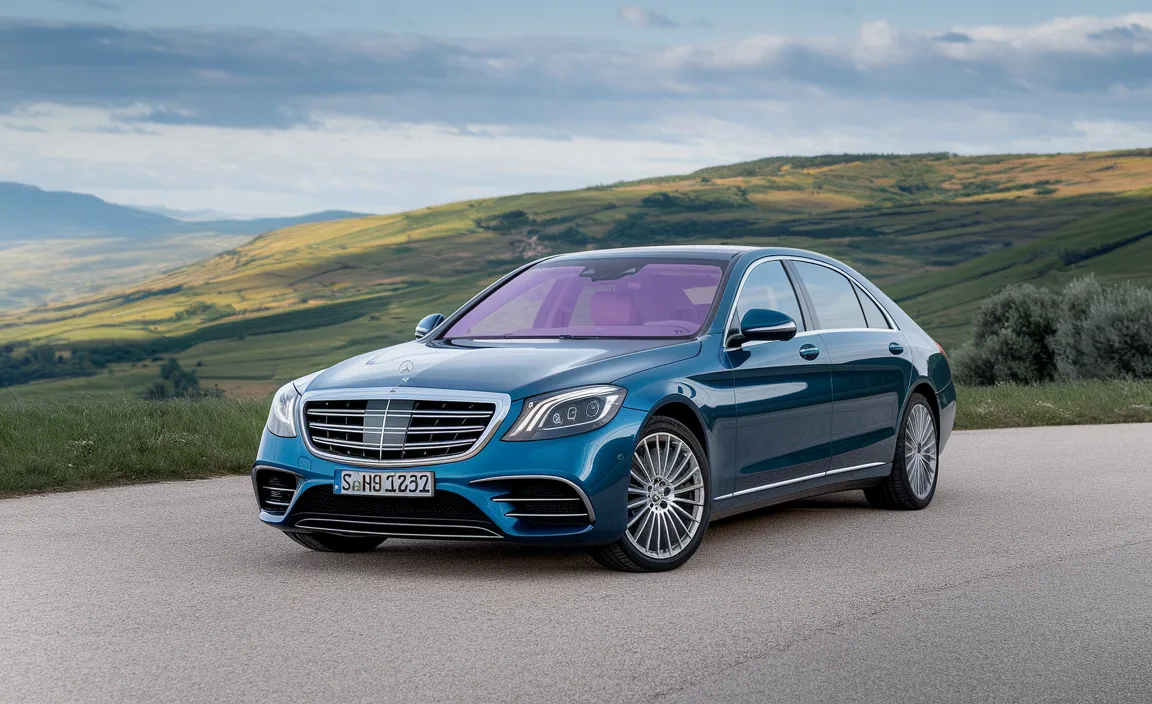Ever wondered how something as magnificent as a Mercedes-Benz S-Class comes to life? It’s not just putting parts together; it’s a symphony of precision, technology, and craftsmanship. Many car owners, whether you drive an A-Class for daily commutes or cherish your E-Class, feel a connection to the German engineering behind these vehicles. The S-Class represents the pinnacle of this, and its production is a fascinating journey. We’ll break down what makes its creation so special, making it easy to understand the dedication that goes into every single one.

You’re about to discover the intricate world of how the Mercedes S-Class is built, from raw materials to the finished, luxurious car that rolls off the assembly line. We’ll explore the advanced factories, the quality control, and the sheer brilliance that earns it the title of “stunning essential.” Get ready to appreciate your Mercedes-Benz even more!
The Genesis of Excellence: What Makes S-Class Production Unique?
The Mercedes-Benz S-Class isn’t just another car; it’s a statement. For decades, it has set the standard for luxury sedans worldwide. Think of it as the flagship, always pushing the boundaries of innovation, comfort, and safety. This means its production process has to be equally exceptional. It’s a blend of age-old craftsmanship and cutting-edge technology, designed to create a vehicle that’s not only beautiful but also incredibly reliable and sophisticated. This careful balance is what truly sets S-Class production apart.
Imagine a place where robots work alongside skilled artisans, where every bolt is tightened with digital precision, and where quality checks are more rigorous than any you can imagine. That’s the environment where an S-Class is born. This isn’t a quick assembly line; it’s a thoughtful process dedicated to perfection. We’re going to delve into the key stages that contribute to this legendary status.
From Blueprint to Reality: The S-Class Manufacturing Journey
The production of a Mercedes-Benz S-Class is a multi-faceted process that occurs primarily in state-of-the-art factories. The main plant responsible for S-Class production is the Factory 56 in Sindelfingen, Germany, often referred to as the “smartest car factory in the world.”

1. Design and Engineering: The Vision Takes Shape
Long before any metal is cut, the S-Class exists as a vision. Teams of designers and engineers work tirelessly to conceptualize, sketch, and digitally model every curve, every feature. This phase involves:
- Aerodynamic Styling: Shaping the car for smooth airflow, which improves efficiency and reduces noise.
- Interior Ergonomics: Designing the cabin for ultimate comfort and intuitive control for driver and passengers.
- Technological Integration: Planning for advanced driver-assistance systems, infotainment, and connectivity.
- Material Science: Selecting the finest, lightest, and most durable materials for every component.
This meticulous planning ensures that the S-Class embodies both aesthetic beauty and functional superiority.
2. Stamping and Body Shop: The Foundation is Built
This is where the car’s skeletal structure begins to take form. Giant presses stamp sheets of high-strength steel and aluminum into specific shapes that will form the car’s body panels and chassis.
- Precision Stamping: Powerful hydraulic presses shape metal with incredible accuracy.
- Body Assembly: Robots, guided by laser and advanced sensors, precisely weld these stamped parts together. This creates the car’s “body-in-white” – essentially, the unpainted shell of the car.
- Quality Assurance: Laser measurement systems check thousands of points on the body to ensure it meets exact specifications, guaranteeing structural integrity and a perfect fit for all subsequent parts.
The body shop is a highly automated environment, showcasing the fusion of mechanical power and robotic precision.
3. Painting: Protection and Polish
The unpainted body shell then enters the paint shop, a critical stage for both aesthetics and longevity. This involves several layers:
- E-Coat (Electrophoretic Coating): The body is dipped into a primer bath. An electric current ensures the primer reaches every nook and cranny, providing crucial corrosion protection.
- Primer Surfacer: Another layer that smooths out imperfections and prepares the surface for paint.
- Base Coat: This is the color layer, responsible for the S-Class’s signature look.
- Clear Coat: A transparent, durable layer that protects the base coat from scratches, UV rays, and gives the car its brilliant shine.
The entire painting process takes place in “clean rooms” to prevent any dust particles from marring the finish. Each layer is precisely applied and often cured with heat.
4. Assembly Line: Bringing It All Together
This is perhaps the most visually dynamic part of the process. The painted body moves along the assembly line, and components are added systematically.
Key Stages in Assembly:
- Interior Fit-out: The dashboard, seats, carpets, and headliner are installed. This is where the S-Class’s luxurious feel truly begins to emerge.
- Powertrain Installation: The engine, transmission, and exhaust systems are carefully lowered into the chassis. For the S-Class, this can range from highly efficient turbocharged engines to the sophisticated hybrid and electric powertrains of its EQ variants (though the S-Class is a distinct model from the EQ range, certain technologies are shared or inspired).
- Exterior Components: Doors, hoods, trunks, lights, windows, wheels, and bumpers are attached.
- Electrical and Electronics: A complex network of wiring harnesses and electronic modules is connected. This brings the advanced infotainment, safety systems, and lighting to life.
- Fluid Fill: Essential fluids like engine oil, coolant, brake fluid, and windshield washer fluid are added.
At Factory 56, this process is heavily supported by automation, including autonomous transport systems that deliver parts precisely when and where they are needed, and robotic arms for heavy lifting. However, critical tasks requiring a human touch, like precise interior finishing or complex electrical connections, are still performed by skilled technicians.
5. Quality Control and Testing: The Final Seal of Approval
Before an S-Class leaves the factory, it undergoes a rigorous multi-stage inspection process to ensure it meets Mercedes-Benz’s unparalleled quality standards.

- Visual Inspection: Every inch of the car is checked for cosmetic flaws – paint imperfections, panel gaps, interior trim alignment.
- Functional Checks: All systems are tested: engine start-up, lights, wipers, infotainment, climate control, power windows, safety systems (like airbag deployment sensors), and more.
- Water Leak Test: The car is sprayed with high-pressure water jets to ensure a watertight seal.
- Performance and Drive Test: Many vehicles are driven on a dedicated test track to assess driving dynamics, braking, acceleration, and suspension performance. Brake tests are performed on a roller rig.
This thorough scrutiny ensures that every S-Class leaving the factory is a perfect representation of the brand’s promise of “The Best or Nothing.”
Innovations in S-Class Production at Factory 56
Mercedes-Benz’s Factory 56 in Sindelfingen is a testament to the future of automotive manufacturing. It incorporates several groundbreaking innovations that enhance efficiency, sustainability, and product quality, which are directly applied to S-Class and other premium models.
Digitalization and AI
Factory 56 leverages a high degree of digitalization. This includes:
- Smart Assembly: Assembly processes are digitally planned and controlled, allowing for flexible production of different model variants on the same line.
- Artificial Intelligence (AI): AI is used for quality control, analyzing images from cameras to identify potential defects much faster and more accurately than human eyes alone.
- Big Data Analytics: By collecting vast amounts of data from sensors on machinery and the assembly line, Mercedes-Benz can optimize processes, predict maintenance needs, and improve overall efficiency.
Sustainability Initiatives
The factory is designed with environmental responsibility in mind:
- Energy Efficiency: The building is designed to be highly energy-efficient, with features like a green roof and integrated solar panels.
- Reduced CO2 Emissions: The production processes are optimized to minimize carbon footprint. Factory 56 aims to be CO2-neutral.
- Resource Conservation: Water usage is minimized, and waste materials are recycled.
For more details on how the automotive industry is embracing sustainability, you can refer to resources like the U.S. Environmental Protection Agency’s Green Power Partnership, which highlights companies committed to renewable energy.
Logistics and Automation
The logistics within Factory 56 are revolutionary:
- Autonomous Transport Systems (ATS): Driverless transport systems move components from warehouses to the assembly line, ensuring timely delivery with minimal human intervention.
- Robotics: Advanced robots perform tasks ranging from welding and screwing to assisting human workers, particularly with repetitive or physically demanding jobs.
- Flexible Assembly: The factory is designed for maximum flexibility, allowing it to produce gasoline, hybrid, and fully electric vehicles on the same line without major retooling. This is crucial as the S-Class lineup includes various powertrain options.
Key Components Driving S-Class Excellence
Beyond the manufacturing process, certain core elements define the S-Class and require specific attention during production:

1. The Powertrain Evolution
Mercedes-Benz is renowned for its engines, and S-Class production involves integrating a range of sophisticated powertrains:
- Inline-6 and V8 Engines: These are finely tuned for power, smoothness, and efficiency, often featuring mild-hybrid technology (EQ Boost) for enhanced performance and reduced emissions.
- Plug-in Hybrids: S-Class models also offer plug-in hybrid variants that combine the power of a combustion engine with electric-only driving capability for shorter trips. The production of these complex systems requires precise integration of battery packs, electric motors, and control units.
- Electric Variants (indirect influence): While the S-Class is distinct from the EQ series, the advancements in electric vehicle production and battery technology developed for models like the EQS certainly influence the overall approach to electrification within the brand.
The integration of these powertrains is a critical step, performed with immense precision to ensure reliability and performance.
2. The Drivetrain and Suspension
The S-Class offers its characteristic smooth, confident ride through advanced drivetrain and suspension systems:
- 4MATIC All-Wheel Drive: Many S-Class models come equipped with 4MATIC, which distributes power to all four wheels for superior traction and stability in various conditions.
- AIRMATIC Air Suspension: Standard on many S-Class variants, this system constantly adjusts suspension damping based on road conditions and driving style, providing a supremely comfortable and composed ride.
- Rear-Axle Steering: For improved maneuverability in urban settings and enhanced stability at higher speeds, the S-Class often features rear-axle steering, further complicating the assembly but adding significant driving benefits.
3. Advanced Electronics and Infotainment
The S-Class is a technological marvel, and its production integrates a vast array of electronic systems:
Key Electronic Systems:
| System | Description | Production Consideration |
|---|---|---|
| MBUX Infotainment System | The centerpiece of the cabin, featuring large touchscreens, AI-powered voice control, and augmented reality navigation. | Requires precise calibration and connection of multiple displays and sensors. |
| Driver Assistance Systems (ADAS) | Adaptive Cruise Control, Lane Keeping Assist, Active Braking Assist, and more, utilizing cameras, radar, and sensors. | Sensors must be perfectly aligned; software integration with steering, braking, and throttle control is complex. |
| Ambient Lighting | Customizable LED lighting throughout the cabin creates a premium atmosphere. | Wiring and integration of numerous light sources. |
| Burmester® Surround Sound System | High-fidelity audio experience often found as standard or optional. | Careful installation of speakers and subwoofers within the cabin acoustics. |
The sheer volume of sensors, cameras, and computing power packed into an S-Class requires incredibly thorough wiring and calibration during production.
4. Luxury Interior Materials
The S-Class is synonymous with luxury, and this is reflected in its materials and craftsmanship:
- Nappa Leather: Hand-stitched leather upholstery is a hallmark. The production line must ensure pristine handling to avoid any damage or contamination.
- Real Wood Trim: Highly polished wood veneers, often sourced from sustainable forests, are carefully fitted.
- Metal Accents: Brushed or polished metal elements are integrated seamlessly.
The assembly process includes specialized stations where these exquisite materials are installed by technicians with a keen eye for detail.
Safety in Production: A Paramount Concern
While we often focus on the safety features of a car, safety within the production itself is equally critical. Mercedes-Benz invests heavily in ensuring the well-being of its employees.
- Ergonomics: The assembly line stations are designed to minimize strain on workers. Robotic aids help with heavy lifting.
- Protective Gear: Employees are provided with and trained to use appropriate personal protective equipment (PPE).
- Safety Protocols: Strict protocols are in place for operating machinery, handling materials, and emergency procedures.
- Automated Monitoring: Sensors and AI are also used to monitor for unsafe conditions, such as potential collisions between robots or transport systems.
This commitment to safety not only protects workers but also contributes to the overall quality and precision of the S-Class production.
The Future of S-Class Production
The production of the Mercedes-Benz S-Class is not static. It’s constantly evolving to incorporate new technologies and adapt to market demands. The ongoing development in areas like:
- Increased Electrification: Further integration of electric and hybrid powertrains.
- Autonomous Driving Technology: Production processes will need to adapt as more autonomous features are integrated and validated.
- Data Integration: Enhanced use of real-time data from vehicles to refine production and inform future designs.
- Sustainability Goals: Continued efforts towards zero-emission production, circular economy principles, and reduced environmental impact.
Mercedes-Benz’s commitment to innovation means that the way the S-Class is produced today will likely look even more advanced in the coming years. To understand how safety standards in vehicle manufacturing are benchmarked globally, you can consult the United Nations Economic Commission for Europe (UNECE) and their work on vehicle regulations, which often influence manufacturing practices worldwide.
Frequently Asked Questions
Q1: Where is the Mercedes-Benz S-Class primarily manufactured?
A1: The Mercedes-Benz S-Class is primarily manufactured at the Factory 56 in Sindelfingen, Germany, which is one of the most advanced automotive production facilities in the world.
Q2: What makes Factory 56 so special for S-Class production?
A2: Factory 56 is known for its high level of digitalization, flexibility in producing various powertrain types (gasoline, hybrid, electric) on the same line, extensive use of automation and AI, and its commitment to sustainability.
Q3: How does Mercedes-Benz ensure the quality of each S-Class?
A3: Quality is ensured through rigorous multi-stage testing, including precise laser measurements in the body shop, meticulous visual inspections of paint and interior, comprehensive functional checks of all systems, and performance tests on a driving track.
Q4: What role do robots play in S-Class production?
A4: Robots are extensively used for repetitive, precise, or heavy tasks such as stamping metal, welding body parts, painting, and assisting in general assembly. These robots work alongside skilled human technicians.
Q5: How is sustainability integrated into the S-Class manufacturing process?
A5: Sustainability is a key focus, with Factory 56 designed for energy efficiency (using solar power and green roofs), aiming for